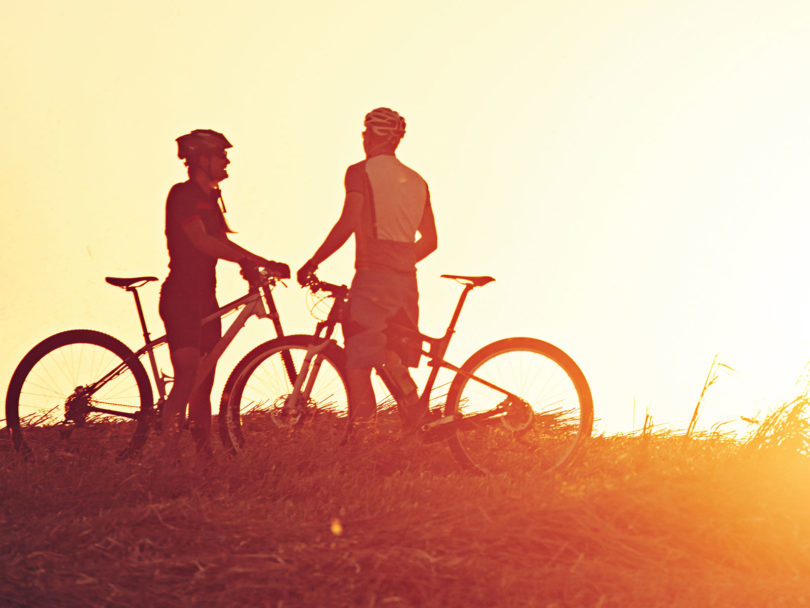Each time you cycle, you have to adapt your body to the bike. Overuse injuries can result from a combination of problems — from how your bike is set up to what demands you put on your muscles throughout the day.
Dr. Robert Pinto, a chiropractor at Pinto Chiropractic & Rehabilitation in Williamsburg, Va., says the key to avoiding these injuries is to correct muscle imbalances. At his office, he helps cyclists find pain relief and avoid future injuries.
There are four overuse injuries that are the most common among cyclists, according to Pinto.
Lower Back Pain
“Almost 60 percent of cyclists have experienced back pain in the last 12 months,” Pinto says. “That’s pretty frequent.”
Most people spend their days in a forward, flexed position such as leaning over a desk — just one of the daily activities that may set you up for back pain. On a bike, you sit in a similar position, which means muscles you used all week are already tired before you even start to ride.
This posture can also lead to muscle imbalances and core stability problems. Here’s why: Each group of muscles works as a pair. When one set of muscles is being used, the other is relaxed. If you are constantly using your hip flexors to sit, your gluteal muscles relax and become weak from lack of use. This imbalance between hip flexors and gluteal muscles is a huge contributor to back pain. This imbalance stresses the lower back causing tightness and then subsequent weakness of the abdominals.
“The biggest part of caring for back pain is actually treating the muscle imbalance and core stability issues that probably made it happen in the first place,” Pinto says. “We have to identify what a person’s particular issues are and help them stretch and strengthen the appropriate muscle groups.”
To treat imbalances, Pinto stretches the tight muscles in your pecs and hip flexors. Then he helps you strengthen the opposing weakened, underused muscles such as the trapezius muscles and glutes. Over time, this combination of stretching and strengthening puts the muscles back in balance and helps prevent future overuse injuries.
Knee Pain
Knee pain is the next most common problem among cyclists, Pinto says. Knee problems can often result from pedal and seat placement — for instance, if the front of your knee hurts, you likely have your seat too low.
But the knee can also suffer from muscle imbalance issues. When the outside of the quadricep muscle gets too tight and the inside grows weak, the kneecap can move in an unbalanced and painful way.
In his office, Pinto uses a variety of techniques to treat knee pain based on its cause. He uses muscle energy techniques to relax the muscle and newer treatments like super-pulsed laser therapy to reduce inflammation. Foam rolling to loosen tight muscles and wearing Kinesio tape applied by a professional can also be helpful.
“The great thing about Kinesio tape is that over time, it can help the muscle strengthen,” he says. “We can tape the weak muscle to facilitate it and help make it stronger, and tape the tight muscle to inhibit it. Over time, using the Kinesio tape will help balance those muscles so they function properly.”
Foot Pain
Foot pain is a common problem among cyclists if they have poor cleat placement on the pedals or because of stiff-soled cycling cleats, both of which can prevent the foot from sitting in a comfortable, natural position.
“We fit cyclists with orthotic inserts for their shoes to put the foot into a better position so it doesn’t fatigue or develop things like plantar fasciitis,” Pinto says. “The insoles tend to make a big difference in most foot pain.”
Hand and Wrist Pain
Wrist pain can come from multiple causes in cyclists. First, you may lean forward if your back gets too tired, which puts more pressure and strain on your handlebars and wrists.
The second cause of hand and wrist pain actually comes from the neck, even if you don’t feel it there.
“All the nerves in your neck go down into your arms and hands,” Pinto says. “Holding your neck in a static, extended position for a long time can pinch and irritate those nerves.”
Pain can also radiate down from the neck and cause numbness in the hands, Pinto says. Though padded gloves may alleviate some hand and wrist pain, the key to getting long-lasting relief is treating the neck itself.
With the right care for your body and the right geometry in your bike — that is, making sure your bike is set up correctly for you — you can avoid cycling overuse injuries. For help with these injuries, contact Pinto Chiropractic & Rehabilitation at (757) 220-8552.

